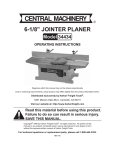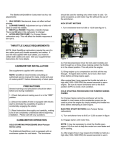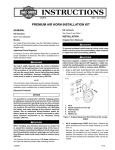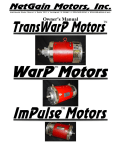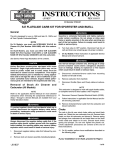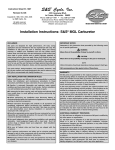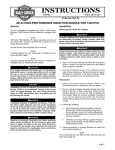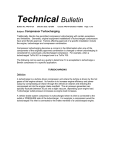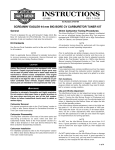Download INSTRUCTIONS - Harley
Transcript
INSTRUCTIONS ® REV. 8-31-01 -J01839 Kit Numbers 27970-00, 27937-00, 28009-00 and 28011-00 SCREAMIN' EAGLE® PERFORMANCE INDUCTION SYSTEM General Kit Contents cont. This kit is designed for use on 1999 and later Carbureted Twin Cam 88 and 1993 and later 1340 Evolution Model Motorcycles. CAUTION Harley-Davidson® motorcycles equipped with some Screamin’ Eagle® high-performance engine parts may not be used on public roads and in some cases must be restricted to closed course competition. This engine related performance part is intended for racing applications and is not legal for sale or use in California on pollution controlled motor vehicles. Engine related performance parts are intended FOR THE EXPERIENCED RIDER ONLY. NOTE S.E. Holley Carburetor Rebuild Kit (P/N 29680-00) and Carburetor Performance Tuning Kit (P/N 29681-00B) are also available from your authorized Harley-Davidson Dealer. Kit Contents This kit consists of the following parts. Some parts are unique to EVO applications (Kit Numbers 27970-00 and 28009-00) and some are unique to Twin Cam applications (Kit Numbers 27973-00 and 28011-00). For detailed carburetor internal parts listing, see Service Parts Illustration on Page x. Qty 3 1 1 1 1 2 2 1 1 2 1 1 1 1 1 1 1 1 3 1 1 1 1 1 Description Bolts, carb to manifold, 5/16x1-1/4 inch Valve, enrichener Guide, enrichener cable Bracket, throttle cable Screw, throttle cable bracket Jet, main size #58 Jet, main size #62 Cable, choke Fuel hose Seal, intake manifold Flange, intake front Flange, intake rear Intake manifold, Evolution Intake manifold, Twin Cam Gasket, carburetor to manifold Carburetor (satin) Carburetor (polished) Hose, breather Stud Back plate, air cleaner Filter element (Evo kit only) Filter element (Twin Cam Kit only) Gasket, back plate to manifold Breather, manifold Part Number 29711-00 29723-00 29724-00 29725-00 29726-00 29731-00 29733-00 29719-00 63631-00 26995-86B 27009-86A 27010-86A 29003-00 29677-00 27972-00 27971-00 28010-00 63534-90 29447-99 29129-00 29675-00 29679-00 29676-00 27900-97 Qty 4 3 2 2 1 2 * 2 2 1 1 1 Description Part Number Clamp, worm drive 3/8 inch 9946 Screw, button head 1/4-20x1/2 inch 4365 Screw, flat head 1/4-20x5/8 inch 3793A Seal, manifold 26995-86B Nipple, 90 degree 63707-00 Washer 46465-99 Washer (6 w/Evo kit), (4 w/TC kit) 45596-93 Banjo bolt (Evo kit only) 45571-97A Banjo bolt (Twin Cam kit only) 45507-99 Bracket, mounting 29133-00 Insert, air cleaner (Evo only) 29448-99 Insert, air cleaner (Twin Cam only) 29450-99 Screamin’ Eagle/Holley Carb Overview The Screamin’ Eagle/Holley Carburetor is a two-barrel carburetor for your Evolution or Twin Cam powered HarleyDavidson. It can be calibrated for all engine configurations. The charts and tuning instructions in this Instruction Sheet will aid in the calibration process. The carburetor has three main components: The Fuel Bowl, The Metering Block, The Mainbody. See Figure 1. The fuel bowl is a fuel reservoir to provide fuel to the different circuits of the carburetor. The metering block is a mixing and delivery service. The mainbody is the inlet for air and the outlet for fuel and air. Figure 1. Three Main Components of Carburetor 1 of 11 Within the three components are five systems: The Float System The Accelerator Pump System The Idle Circuit The Transfer or Slow Speed Circuit The Main or High Speed Circuit Idle Circuit Float System The Float System located in the fuel bowl is critical for all circuits of the carburetor. It regulates the amount of fuel in the fuel bowl that will be available to the different circuits of the carburetor. If set to low, all circuits will run lean. If set too high, all circuits will run rich. Accelerator Pump System The Accelerator Pump System provides the carburetor with extra fuel to aid in acceleration, letting the carburetor smoothly transition from idle to off idle to the main circuit when the bike is accelerated. The amount of fuel fed by the accelerator pump system is controlled by the size of the discharge holes in the accelerator pump discharge nozzle. The accelerator pump discharge nozzle is located in the mainbody. Refer to Figure 1. A pump circuit with too small of an accelerator pump discharge nozzle hole size will cause the bike to hesitate and possibly backfire from the carburetor. Too large of an accelerator pump discharge nozzle hole size and the bike will be lazy during acceleration with black smoke being emitted from the tailpipe. A correctly sized pump discharge nozzle will give crisp, clean accelerations. Idle Circuit The Idle Circuit is used to deliver a mixture of fuel and air to the engine during idle. It will only work for a very short time off idle before stopping and letting the transfer circuit takeover. The fuel air mixture is adjusted by the idle mixture screws (in the metering block) and metered by the idle fee restrictions (in the mainbody). Figures 2 and 3. Setting(s) that are too rich give poor idle quality and black smoke out of the exhaust. Settings that are too lean give poor idle quality with hesitations during accelerations. Transfer Circuit (Slow Speed) The Transfer Circuit is used to deliver a mixture of fuel and air to the engine during off idle and cruise range. Its fuel is metered by two restrictions in the mainbody that deliver fuel to the transfer slot located in the throttle bore of the mainbody. See Figure 3. Calibrating too lean will result in poor drivability in the cruise range with spitting out of the carburetor. Calibrating too rich will result in poor drivability in the cruise range with popping out the exhaust and a possible engine miss at cruise speeds. Figure 2. Idle Circuit and Accelerator Pump System Transfer or Slow Speed Circuit Main or High Speed Circuit Main Circuit (High Speed) The Main Circuit is used to deliver a mixture of fuel and air to the engine during high rpm usage. Fuel for the main circuit is drawn through the main metering jets (See Figure 4) and discharged through the booster venturi’s. Whether the main circuit is rich or lean will result in a loss of power. The main circuit is best tested at the track or on a dynamometer but can be calibrated by “feel” while driving the bike. A main circuit that is too rich or too lean will make the motorcycle feel lazy. Let plug readings tell you if it is too rich or too lean. Figure 3. Metering Block and Fuel Bowl (Metering Jets) -J01839 2 of 11 Installation NOTE Refer to applicable Service Manual for detailed instructions on how to remove necessary components in order to access the carburetor. Service Manuals are available from your Harley-Davidson Dealer. 1WARNING To protect against shock and accidental start-up of vehicle, disconnect the negative battery cable before proceeding. Inadequate safety precautions could result in death or serious injury. 1WARNING 8. See Figure 5. Disassemble the stock enrichener cable assembly. Remove the enrichener valve, spring, plastic nut, 90 degree elbow, hex nut and star washer from the cable. 9. Obtain the new enrichener cable (P/N 29719-00) from kit and install the star washer and hex nut just removed from the existing assembly. Install the rubber boot over the straight steel cable guide (P/N 29724-00). Install the original plastic nut and spring along with the new enrichener valve (P/N 29723-00). 10. Install the enrichener cable assembly to the back of the new carburetor. Disassembled Enrichener Cable Always disconnect the negative battery cable first. If the positive cable should contact ground with the negative cable installed, the resulting sparks may cause a battery explosion which could result in death or serious injury. 1. Disconnect negative battery cable. 2. Following instructions in applicable Service Manual, remove stock air cleaner, carburetor and intake manifold. 3. See Figure 4. Remove the stock enrichener cable assembly from the original carburetor. Figure 4. Stock Enrichener Cable Assembly 4. If the stock intake manifold has a MAP sensor installed, remove it and install it into the intake manifold supplied with the kit. 5. Install new seals and flanges to intake manifold. New Cable Guide New Enrichener Valve Assembled Enrichener Cable Figure 5. Assemble Enrichener Cable 11. See Figure 6. Obtain manifold gasket (P/N 27972-00) and position between manifold and gasket as shown. NOTE Make sure the manifold flanges are installed correctly. The flanges are designated “F” for the front and “R” for the rear cylinder. 6. Connect the vacuum hose to the fitting on the manifold and the electrical connector to the MAP sensor, if present. NOTE If your fuel petcock has been changed and no longer uses the vacuum line from the original petcock to the intake manifold, the port on the top of the new manifold needs to be capped and the vacuum line needs to be plugged. 7. Install the manifold to the cylinder heads and finger tighten only at this time. -J01839 Figure 6. Position Manifold Gasket 3 of 11 12. See Figure 7. Use the three 1-1/4X5/16 inch bolts (P/N 29711-00) from kit and while holding gasket in place, install the carburetor to the new intake manifold. 90 degree Fitting Figure 9. Install Hose Fitting to Backplate Figure 7. Install Carburetor 13. Place one large ID washer (P/N 45596-93) over each banjo bolt (TC-P/N 45507-99, EVO-P/N 45571-97A). Insert the bolts through the holes in the mounting bracket (P/N 29133-00), then place a second large ID washer over each banjo bolt. Place the breather manifold (P/N 27900-97) over the banjo bolts with the hose fitting on the manifold toward the rear of the bike. Place the remaining two washers (TC-P/N 46465-99, EVO-P/N 45596-93) over the breather bolts. NOTE On Twin Cam engines, the last washers will have small ID. 14. See Figure 8. While holding the assembly together, insert the banjo bolts into the tapped holes in the cylinder heads. Tighten each bolt a little at a time until the assembly is loosely held in place. 16. See Figure 10. Install the backing plate gasket (P/N 29676-00) and backing plate to the front of the carburetor using three studs (P/N 26447-99). Align the backing plate to the bracket by installing the two 1/4-20x5/8” flat head screws (P/N 3793A) to the mounting bracket. Do NOT tighten. 17. Finger tighten the banjo bolts (installed into heads) to align the carburetor backplate and intake manifold. 18. Making sure everything is aligned, tighten the rear cylinder intake manifold bolts on left (sparkplug) side of engine) to secure the manifold in position. 19. Remove the backing plate, mounting bracket, manifold breather tube and carburetor assembly then tighten the front cylinder intake manifold bolts on right (pushrod) side of engine. Screws Manifold Breather Banjo Bolt Studs Mounting Bracket Figure 10. Install Backing Plate Figure 8. Install Mounting Bracket Assembly 15. See Figure 9. Obtain the 90 degree nipple hose fitting (P/N 63707-00) and screw into the backside of the backing plate (P/N 29129-00). Do NOT overtighten. The hose fitting should be pointing toward the back of the motorcycle after installation. -J01839 4 of 11 20. See Figure 11. Route and connect the throttle cables to the carburetor throttle wheel. 1WARNING Refer to the applicable Service Manual and ensure that the throttle cables are of the correct length and are routed correctly. If the cables are not of the correct length or routed correctly, they could interfere with the operation of the motorcycle. This could cause loss of control of vehicle which could result in death or serious injury. Bracket Bracket Screw Figure 13. Install Bracket to Carburetor 23. See Figure 14. Reinstall the intake manifold gasket and carburetor to the intake manifold using three 5/16x1-1/4 inch bolts (P/N 29711-00). Tighten to 10-12 ft-lbs (13.616.3 Nm). Figure 11. Connect Throttle Cables To Throttle Wheel 21. See Figure 12. Obtain the new throttle cable bracket (P/N 29725-00) and bracket screw (P/N 29726-00), and install the throttle cables into the bracket. Throttle Cable Bracket Figure 14. Reinstall Intake Manifold Gasket and Carburetor to Manifold 1WARNING Figure 12. Install Throttle Cables to Bracket 22. See Figure 13. Install bracket onto carburetor and torque screw to 3-5 ft-lbs (4.1-6.8 Nm). Refer to the applicable Service Manual and ensure that throttle cables are of the correct length and are routed correctly. If the cables are not of the correct length or routed correctly, they could interfere with the operation of the motorcycle. This could cause loss of control of vehicle which could result in death or serious injury. 24. The throttle control must operate freely without binding. With the friction adjusting screw backed off, the carburetor throttle must return to the closed (idle) position. Perform Steps a through c to adjust the throttle cables. CAUTION The throttle cable adjustment is necessary to prevent excess stress and potential failure to the throttle cables. -J01839 5 of 11 NOTE The throttle cable has a 5/16x18 inch threaded adjuster and is assembled to the right side of the throttle grip. The idle cable has a 1/4x20 inch threaded adjuster and is assembled to the left side of the throttle grip. a. Turn the cable adjusters and locknuts clockwise as far as they will go. Both cables should have zero adjustment to start this procedure. b. See Figure 15. Point the front wheel straight ahead. Turn the throttle grip so throttle is wide open (fully counter-clockwise) and hold it there. Now turn the throttle cable adjuster (1) counter-clockwise until the throttle cam stop just touches the stop boss on the carburetor. Tighten the locknut (2) against the throttle cable adjuster and release the throttle. c. 29. Refer to Figure 6. Reinstall the carburetor-to-backing plate gasket and backing plate to carburetor and mounting bracket using two flat head screws (P/N 3793A) and three 1/4-20 studs (P/N 29447-99). Tighten all five fasteners 3-5 ft-lbs (4.1-6.8 Nm). 30. Tighten the manifold breather tube banjo bolts to 10-12 ft-lbs (13.6-16.3 Nm). NOTE It may be necessary to shorten the “short end” of your allen wrench to tighten the bolts. 31. See Figure 16. Attach the short end of the manifold breather hose to the 90 degree fitting on the backside of the backing plate and secure with 3/8” hose clamp (P/N 9946). Turn the front wheel full right. Turn the idle cable adjuster counter-clockwise until the idle cable housing just touches the spring in the cable support sleeve. Work the throttle grip to make sure throttle cable returns to idle position when released. If the cable does not return to idle, turn the cable adjuster clockwise to achieve the correct adjustment. Tighten the idle cable adjuster locknut against the idle cable adjuster. Check adjustment by turning forks to full left, full right lock, and straight ahead. Figure 16. Install Breather Hose to Backing Plate 32. See Figure 17. Cut the long end of the manifold breather hose to the correct length, connect it to the manifold breather and secure with 3/8” hose clamp (P/N 9946). Figure 15. Throttle Cable Adjustment (1995 Switch Housings Shown) 25. Check carburetor for correct throttle opening and closing. Correct any existing problems at this point before proceeding. 26. Obtain fuel hose (P/N 63631-00) from kit and install one end on the carburetor fuel bowl inlet. Secure end with 3/8” hose clamp (P/N 9946). 27. Route fuel hose through its original position using the original protective sleeves. Attach the end to the fuel supply valve and secure using 3/8” hose clamp (P/N 9946). 28. Apply a small amount of Loctite 243 (blue) to the banjo bolts and reinstall the manifold breather tube, bracket and banjo bolt assembly to the cylinder heads. -J01839 Figure 17. Install Breather Hose to Manifold 33. See Figure 18. Install the air filter (TC-P/N 29679-99 or EVO P/N 29675-00) to the backing plate and secure with three button head screws (P/N 4365). Tighten to 35 ft-lbs (4.1-6.8 Nm). 6 of 11 Check Enrichener Adjustment NOTE Check enrichener operation. The fuel enrichener knob should open, remain open, then close without binding. The knurled plastic nut next to the enrichener knob controls the ease or difficulty with which the cable slides within the cable conduit. If adjustment is needed perform Steps a through e. as follows: a. Loosen hex nut at backside of mounting bracket. b. Move cable assembly free of slot in mounting bracket. c. Hold cable assembly at flats with adjustable wrench. Turn knurled plastic nut counter-clockwise by hand, to reduce sliding resistance until knob slides inward unaided. d. Turn plastic nut clockwise to increase sliding resistance until knob remains fully out without holding and closes with relative ease. e. Position cable assembly in slot in bracket. Tighten hex nut at backside of bracket. Figure 18. Install Air Filter 34. See Figure 19. Apply Loctite 243 (blue) to threads of cover screw removed from original air cleaner and install cover using screw and washer. CAUTION Do not lubricate the cable or inside of conduit. The cable must have sliding resistance to operate properly. 36. Recheck throttle cable operation. 1WARNING Always connect the positive battery cable first. If the positive cable should contact ground with the negative cable installed, the resulting sparks may cause a battery explosion resulting in death or serious injury. Figure 19. Install Air Cleaner Cover 35. Secure the enrichener cable to its bracket on the left side of the motorcycle. 37. Connect the battery cables, positive cable first. 38. Start the motorcycle per procedure outlined in your Owners Manual or applicable Service Manual. Once engine is warm, set idle speed set screw according to Manual specifications, usually 1000 RPM. NOTE If original petcock is still being used, it may take several seconds for enough fuel to enter the fuel bowl to start the motorcycle. 39. Drive the motorcycle and check engine performance. If engine performance is unsatisfactory, tune the carburetor following instructions under Carburetor Tuning Procedures in these instructions. -J01839 7 of 11 Carburetor Tuning Procedures: General Jetting Nomenclature Fuel Restrictors are called “Feeds”. Air Restrictors are called “Bleeds”. NOTE Additional main metering jets and transfer feed restrictions for tuning are included in the TUNERS KIT (P/N 29681-00). c. See Figure 21. Make sure to reinstall the pump check needle into the pump passage of the fuel bowl before the bowl is installed. The pointed end of the needle goes in the passage first. Reinstall the fuel bowl. Pump Passage Accelerator Pump Check Needle Float System The Float Level is set at the factory and should not need adjustment. In the event that adjustment becomes necessary use the following procedure. Fuel Bowl CAUTION When removing the fuel bowl from the carburetor, be careful not to drop the accelerator pump check needle from the accelerator pump fuel passage. a. Remove the fuel bowl from the carburetor. b. See Figure 20. Press against the float tab until the float is in its full UP position. Measure from the outer end or “toe” of the float to the top edge of the fuel bowl. This measurement should be .475 inch. To adjust, loosen the needle and seat lock screw and turn the adjusting nut clockwise to lower the level and counter-clockwise to raise the level. Retighten the lock screw. Note the following: * Too high of a float level can be identified by a loss of idle quality when the bike is set on its kick stand. * Too low of a float level can be identified by a lean condition that can only be calibrated out by using excessively large transfer feed restrictions and main jets. Figure 21. Float Bowl Idle Mixture Screws (IMS) and Idle Feed Restrictions See Figure 22. There are two brass feed restrictions located on the bottom surface of the carburetor main body, above the metering block. The idle feed restrictions are the two outer feeds, located on this surface. IMPORTANT It is not recommended to change these idle feed restrictions from the .022 that are installed in the as-received carburetor, since IMS setting will have the same effect. The IMS are located in the left and right sides of the metering block, and are fuel flow adjusters for idle and part throttle load ranges. Turning the IMS “IN” (clockwise) leans the carburetor and turning it “OUT” (counterclockwise) enriches the carburetor. NOTE: The normal range for the IMS is 1/2 to 3 turns “OUT”. Figure 20. Float Adjustment Figure 22. Metering Block -J01839 8 of 11 With the as-received carburetor, the IMS setting should be set to approximately 1 turn out. If the engine exhibits a rich or lean condition at idle or up to 3/8 throttle opening, adjusting the Idle Mixture Screw (IMS) may correct the condition without having to change transfer feed restrictions. If required, adjust the two screws, in or out, to obtain a steady idle speed. Idle speed should be reset to approximately 1000 rpm, after each adjustment. Slight hesitations right off idle usually can be attributed to IMS setting that is too lean even if the engine is idling smoothly. Turning each IMS out 1/8th to ....turn should correct this. If you have access to Air/Fuel ratio (AFR) sensors, target an AFR of 13.0:1 at idle. If the engine runs well at either 1/2 or 3 turns extreme, change to one step leaner (smaller) or one step richer (larger) Transfer Feed Restrictions (TF’s). Then, reset the IMS away from the extreme positions. Transfer Feeds (TF)Refer to Figure 22. The transfer feeds (TF) are the slow speed jets located on the bottom surface of the carburetor main body, above the metering block. They are the two inner feeds. The Transfer Feeds affect off idle and cruise operation up to approximately 70 mph. Start with the .022 TF’s installed into the as-received carburetor. If the engine exhibits leanness (spitting, sluggish), at off-idle transients or at cruising speeds, the TF’s will need to be increased in size. Sizes from .024”, .026”, and .028” are included in the Tuners Kit (Part Number 29681-00). Increases in transfer feed restriction size may allow for a smaller main jet and vice-versa. Figure 23. Bottom Surface of Metering Plate Accelerator Pump Discharge Nozzle (PD Nozzle) The PD Nozzle is located in the lower front center of the carburetor air inlet. Refer back to Figure 1. There are two discharge holes located on the backside, oriented so they hit the sides of the booster venturis. With engine off, rotate throttle to verify fuel is being discharged from both discharge holes. If not, remove nozzle and blow compressed air through each hole. 1. Start with the .016 inch PD nozzle installed in the asreceived carburetor. If you experience slow throttle response during acceleration, or a hesitation that cannot be removed by IMS adjustment, or there is a dip in the torque curve at low rpm’s when running on a dynamometer, increase to the larger .018” PD Nozzle, included in the Tuners Kit. 2. Check the pump rod adjustment. A improperly adjusted pump rod can cause off-idle hesitations. During development of this carburetor, no larger TF’s than .024” were found to be required with engines ranging from stock EVO’s to 1550 Twin Cam engines, equipped with Screamin” Eagle cams and heads. Your engine may vary. If no change is noted in the operation of the engine after changing to larger Feeds, there may be restrictions in the circuits. To check for any restriction in these circuits, disassemble the carburetor to remove the metering block. Located on the bottom surface of the metering plate are five brass tubes that extend into the float bowl. See Figure 23. The two larger center tubes hold the main jets, while the smaller back ones are the idle/transfer feed tubes. The fifth smaller tube inbetween the main jet tubes is for the choke fuel pick-up. Using a spray carburetor cleaner, and high-pressure air, flush these tubes out, in the direction of fuel flow, from the end of the brass tube toward the body of the metering block. NOTE Don’t attempt to flush these circuits in a reverse direction, from metering block toward brass tubes. You can force any debris that may be present in these passages, into the small restrictions at the float bowl end of the tubes. To assist in seeing any small debris that may be present in these circuits, place the metering block on a clean white rag and flush the tubes out on to this rag. It may also be necessary to use the spray cleaner and high-pressure air to flush out each passage in the mainbody. -J01839 See Figure 24. To adjust the pump rod, perform the following.: a. Remove the cotter pin from the pump rod and remove the pump rod from the pump cover exten sion arm. b. With the pump rod in the full upward position and the pump cover extension arm in the full down ward position (without compressing the pump diaphragm) half of the rod end should be visible in the lower half of the pump cover extension arm hole. c. If more or less of the pump rod is visible, loosen the jam nut and turn adjusting barrel to lengthen or shorten the rod. Retighten the jam nut and turn adjusting barrel to lengthen or shorten the rod. Retighten the jam nut, reinstall the pump rod in the pump cover extension armhole and reinstall the cotter pin. 9 of 11 Adjusting Barrel Jam Nut Figure 24. Accelerator Pump Rod Adjustment Main Jets The main jets are located at the bottom of the large brass tubes, which are located on the bottom surface of the metering block. Refer to Figure 23. 1. Start with the suggested jetting listed in the chart (Figure 25) and change as required. Sizes ranging from 56 up to 70 main jets are included in the Tuners Kit. Larger sizes are available from a Holley distributor. NOTE The best way to adjust the main jets is either on the racetrack or using a chassis dynomometer but they can be calibrated by “feel” while driving the bike. A main system that is too rich or too lean will make the motorcycle feel lazy. Let plug readings tell you if the engine is running too rich or too lean. 2. 3 Start with the jet sizes suggested in the chart, then increase jet sizes until the fastest bike speed is obtained on the track, or maximum power is acheived on the dyno. If you have access to oxygen sensors to measure the exhaust’s AFR, target an AFR of 12.0 to 12.5:1, at the higher engine speeds. This should be the average of the front and rear cylinders. Air Bleeds There are four air bleeds located in the lower front of the carburetor air inlet. The outer ones are for the idle and transfer circuits and are called the Idle Air Bleeds (IAB). The inner ones are for the main circuit and are called High Speed Bleeds (HSB). These air bleeds work in conjunction with their respective fuel feeds to feed atomized fuel to the engine. NOTE Harley-Davidson doesn’t recommend changing these bleeds, and so doesn’t include any with the Tuners Kit. If you have a need to adjust the sizes of these bleeds, you will need to obtain additional sizes from a Holley distributor. NOTE All development testing at Harley-Davidson was performed using Harley-Davidson Screamin’ Eagle parts. We have no experience with combinations involving aftermarket supplier’s parts. The results with using other supplier’s parts may change the suggestions in the Table shown below. NOTE Jetting with identical engine configurations on different bike platforms; touring versus shorty-dual exhaust systems, was similar when using Screamin’ Eagle touring and shorty-dual mufflers. Air Cleaner Maintenance 1. Remove the air cleaner cover and inspect the element every 5000 miles or more often under dusty conditions. 2. To clean the element, remove and wash by rolling it on edge in a shallow pan containing enough Air Cleaner/Degreaser (P/N 99883-88T) to cover no more than 3/4 depth of filter pleats. Do not let solution get inside element. 3. Remove the element from the Cleaner/Degreaser and allow five minutes to dissolve dirt. From the inside out, rinse element with cold water, shake and let air dry. Do not dry with compressed air. 4. Re-oil element. Apply along full length of each pleat and allow to set until all is uniform color. Allow excess to drain and reinstall. A set of #58 MMJ (leaner) jets are included in the kit for engines that exhibit a rich condition and a set of #62 MMJ (richer) jets for engines that exhibit lean conditions. Screamin Eagle/Holley Carburetor Tuning Information Engine 1340 EVO Mufflers SE Slip-Fit 1450 TC SE Slip-Fit 1550 TC SE Slip-Fit -J01839 Initial Jetting Suggestions Cam Transfer Feeds No 22 Yes 22/24 No 22 Yes 22/24 No 22/24 Yes 22/24 Main Jets 58 62 60 62 62 64 10 of 11 ® ® Service Parts Part No. 28009-00 and others Date 8/01 SE Performance Induction System i03094 9 10 11 13 12 14 15 16 8 1 2 18 3 4 7 17 5 6 ITEM 1 2 3 4 5 6 7 8 9 10 DESCRIPTION Fuel Inlet Lock Screw Gasket Fuel Inlet Adjustment Nut Gasket Fuel Inlet Needle and Seat Assembly Drain Plug Gasket Accelerator Pump Diaphragm Fuel Bowl Screw Gasket (4) Accelerator Pump Check Valve Cotter Pin E-ring (2) Pump Discharge Nozzle Gasket (inner) -J01839 PART NO. 29708-00 29690-00 29709-00 29689-00 29712-00 29683-00 29710-00 29682-00 29729-00 ITEM 11 12 13 14 15 16 17 18 DESCRIPTION PART NO. Pump Discharge Nozzle (.016” stock) 29728-00 Pump Discharge Nozzle Gasket (outer) 29686-00 Metering Block Gasket 29685-00 O-ring (2) 29688-00 Main Jet (2), (#60 stock) 29732-00 Fuel Bowl Gasket 29684-00B Transfer Feed (2) (#22 stock) 29721-00 Needle Valve, Accelerator Pump Discharge 29779-01 29687-00 11 of 11











